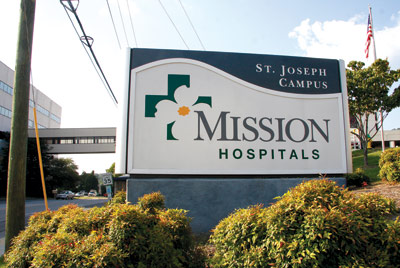By July 1, 2013, Mission Hospital hopes to be down to zero. On March 26, the hospital's board voted to institute a "zero preventable harm" policy, meaning patients should not be negatively affected in any avoidable way during their stay.

Already a national leader in quality care and cost-effectiveness, Mission was invited to speak at a 2009 Institute for Healthcare Improvement symposium titled "How Do They Do That?" which spotlighted some of the nation's top-performing hospitals. Hospital representatives put in a similar appearance at another such conference this year.
According to board Chair George Renfro, Mission already "exceeds national averages on everything." Far from being content, however, the hospital is committed to getting better in every way.
"We're good, and a lot of institutions would be happy with that, but we're not," says Janet Moore, director of external communications. "The board of directors," she says, wants "to put Asheville on the map in terms of quality."
A fundamental shift
Hospitals across the country are looking for ways to limit human error and adopt more effective medical practices. Proponents of the movement focus on curbing mistakes in administering medications while improving hygiene and medical procedures.
Mission's goal for the month of April, for example, was to cut urinary tract infections by 10 percent; in fact, they decreased by 20 percent. But zero preventable harm means even this impressive result is not enough.
According to Chief Medical Officer Dale Fell, Mission has been "whittling away project by project for the last two or three years … but now we're aiming for zero." This represents a basic philosophical shift: Ten years ago, instances of preventable harm were viewed as inevitable for a certain percentage of patients. Increasingly, however, these cases are being viewed as "people, not just statistics," he notes.
Achieving this ambitious goal would place Mission in "the top 10 percent of hospitals in the country" in terms of quality of care, says Chief of Staff Alan Baumgarten. "Specifically," notes Renfro, "the hospital is taking aim at infections, falls and bedsores." The goal, Fell explains, is to "make sure we don't hurt [the patient]." Renfro, meanwhile, describes the current transition as "a good-to-great process." The hospital aims to eliminate all preventable harm within three years.
Tech fixes
The campaign will necessarily involve many different programs and initiatives. To address the risk of falling, for example, Mission has begun flagging patients at high risk for a fall when they're admitted and posting warning signs in those rooms.
To avoid medication errors, the hospital is developing a system using bar-coded wristbands. Nurses will first scan the wristband (which will indicate what's been prescribed) and then the medication's bar code; only after the two have been matched will the nurse dispense the drug. This will greatly decrease the risk of hanging the wrong IV bag or handing out the wrong pills. Mission, says Renfro, will invest $5 to $6 million in this program.
The hospital also plans a significant investment in software designed to determine the best health-care practices. Gathering statistical data from Mission and other hospitals nationwide, the software will identify the protocols and procedures that statistically provide the best outcomes for patients. It can also help create checklists spelling out how a patient with a particular condition should be treated, taking some of the guessing out of medicine.
These "best practices," notes Fell, will enable the hospital to "transform data into information." In the past, obtaining such statistics would have been too difficult and time-consuming, but with the new software, hospitals "can concentrate on making changes rather than data," he explains.
A team effort
Another key component, says Moore, is improving communication between patients and caregivers, whether doctors, nurses or other staff. "It takes a village to care for a patient, too," she observes.
The hospital also wants to help patients "become involved in [their] care." A retooled Web site, now in the works, will enable "anyone to see how [Mission] is doing," says Fell. The site will include a glossary of commonly used medical terms.
To a layperson, notes Moore, the things doctors say often "might as well be in another language." Hospitals, says the former high-school English teacher, can be intimidating for patients, who often don't know what doctors are actually doing thanks to this language gap. Helping patients understand their treatment can improve the level of care while increasing doctors' and nurses' accountability.
But ultimately, stresses Fell, improving care and eliminating harm must include everyone who works at the hospital as well as the community at large. "Medicine is a team sport," he proclaims, and "Everybody plays a role. A cleaning person here should say their job is to clean rooms and cut down infections in the hospital."
Visitors, meanwhile, should take responsibility for such things as washing their hands upon arrival and frequently thereafter to limit the spread of infections. A planned "learning resource center" will educate staff and community members alike on how they can help Mission achieve its goals. "Education and communication are hallmarks," notes Fell.
But eliminating all preventable harm means setting the bar even higher. "Physicians," says Renfro, "have really been pushing for this."
"We keep getting closer and closer to zero" adds Fell — and now the clock is ticking.
Xpress intern Gabe Chess is a junior at Asheville High.



Very informative article and nicely written.